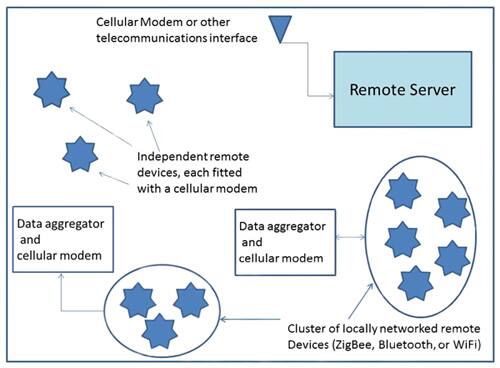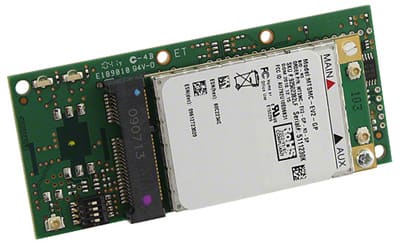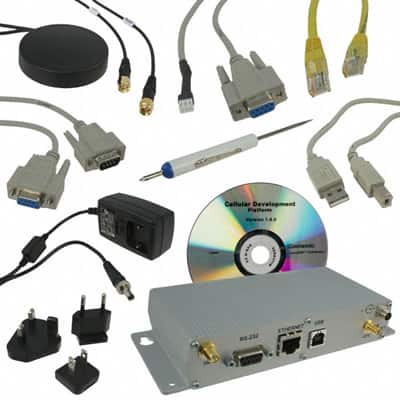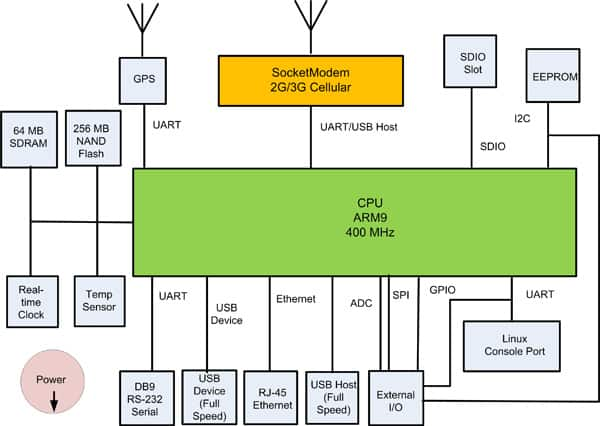Cellular Modems Leverage Existing Infrastructure to Lower Communications Overhead
投稿人:电子产品
2013-08-29
When setting up the infrastructure for machine-to-machine (M2M) communications, systems will leverage various wireless networking schemes for interconnection. However, to leverage wireless network standards such as 802.11 (Wi-Fi), ZigBee, and other data-network standards, additional subsystems such as access points, routers, and other network-related hardware must also be installed. For designers, a viable alternative to using data networking to send data across M2M networks is the already-installed cellular telephone network. In many cases, the data network products such Wi-Fi or ZigBee, or even a proprietary solution can work in tandem with the cellular network by collecting the data from nearby M2M devices and then aggregating it. The aggregated data is then sent over the cellular network to the central host location.
Therefore, rather than install a dedicated, on-all-the-time Ethernet connection that could continuously send data back to the central system, a cellular system can be set to send data on a regular schedule in short or long bursts, depending on the amount of data and the throughput of the cellular connection. Each of the connected devices, vending machines, medical equipment, smart appliances, utility networks, industrial systems, and others could have a cellular modem if they are not in close proximity to each other. When several devices are relatively close, using short-range data networking such as ZigBee, Bluetooth, Wi-Fi, or other wireless interface to send data to a local aggregation point could reduce the hardware costs. Once data is aggregated, a cellular modem can be used to transfer the data to the host system using one of the many cellular standards (GSM, EDGE, HSPA, LTE, and more, Figure 1). As costs come down for cellular modems, each device in the field could be fitted with its own modem.

Cellular modem modules
Cellular modem module shipments are growing at about 21 percent a year according to ABI Research. That growth encompasses five world regions, and seven air-interface technologies covering 2G, 3G, and 4G standards. Today, designers can design their own cellular modems thanks to the wide availability of baseband chips and RF front-ends typically used in cell phones. However, such offerings require a designer’s expertise to layout and implement a full board design, which is often a lengthy process. In many cases, it would probably be more economical and time-efficient to purchase an embeddable module such as the iCell intelligent Socketmodem, the Cell Socketmodem module, or the SocketModem Edge from Multi-Tech Systems (Figure 2).

Both the iCell and Cell modules connect via 2G and 3G interfaces based on the dual-band (800/1,900 MHz) EV-DO Rev A standard, which is backward compatible with EV-DO Rev 0 and CDMA2000 1xRTT. An embedded universal-IP stack allows for automatic/persistent connectivity for mission-critical applications and enhanced M2M functionality. A GPS capability permits the module to be used in applications that require product tracking (for example, truck fleet management). The modules can interface to the system using a serial or USB port, with the serial DTE interface able to handle data rates of 921.6 kbits/s.
The Multi-Tech SocketModem Cell cellular modem is a complete, ready-to-integrate communications device that offers standards-based dual-band CDMA2000 1xRTT performance. This quick-to-market communications device allows developers to add wireless communication to products with minimum development time and expense. The SocketModem Cell cellular modem is based on industry-standard open interfaces and uses Multi-Tech's Universal Socket design (a dev kit is available for Universal Socket SocketModem products). The SocketModem Cell integrates the controller, RF transceiver, and antenna interface into one device. This integration requires low power, low real estate, and provides an overall reduction in costs.
A full development kit, the Multiconnect OCG-D, pulls together a cellular hardware development kit that includes the modem, cables, and Multi-Tech’s Core CDP, a distribution version of the Linux operating system, and a complete Linux build environment so designers can craft their custom applications in short order (Figure 3). The modem itself consists of an ARM9 processor that performs all the housekeeping and control of the SocketModem (Figure 4). The modem is pre-packaged in a compact metal case that includes USB host and device ports, an RS-232 port, a 10/100-Mbit Ethernet port, and a 36-pin general-purpose I/O port that can be customized for the application, (see the foreground image in Figure 3), and includes SPI, I²C, serial, ADC, and GPS connections.


Hardware specifications for the OCD-G include the 400 MHz ARM9 CPU, 256 Mbyte NAND flash, 64 Mbyte SDRAM, and a 2 Gbyte industrial-grade SD flash card. All MultiConnect OCG-D developer kits and deployment models are PTCRB approved, relieving engineers of the burden and expense of obtaining these approvals independently. (The PTCRB was established in 1997 as the wireless device certification forum by North American Mobile Network Operators. The purpose of the PTCRB is to provide the framework within which cellular GERAN (GSM), UTRA (UMTS) and E-UTRA (LTE) mobile devices and modules obtain certification for use on PTCRB Operator networks.)
For more information on the parts discussed in this article, use the links provided to access product pages on the DigiKey website.
免责声明:各个作者和/或论坛参与者在本网站发表的观点、看法和意见不代表 DigiKey 的观点、看法和意见,也不代表 DigiKey 官方政策。





